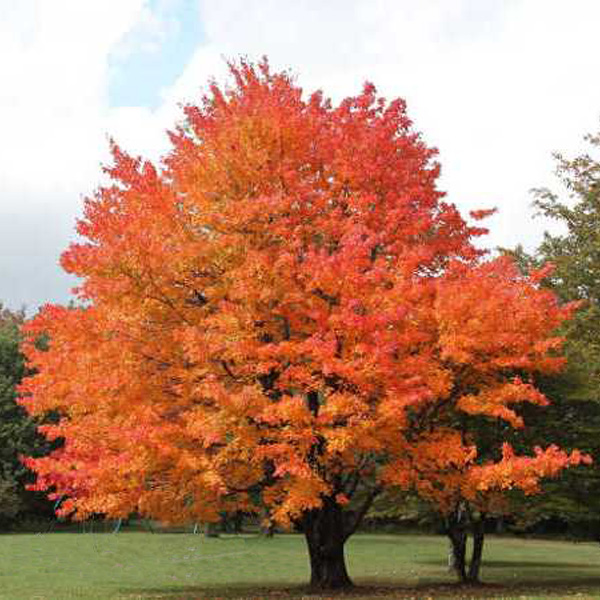Acer saccharum
 Latin name: Acer saccharum
Latin name: Acer saccharum
Common name: Sugar maple
Flowers: Panicle, green/yellow/red, bloom in spring, < 1 inch 13
Fruit or cones: Samara 13
Height & Width: Height: 40 ft. 0 in. - 120 ft. 0 in 13 Width: 30 ft. 0 in. - 60 ft. 0 in 13
Type: Deciduous 13
Habit: Open 13
Wetland indicator category**: FAC 17
Texture: Medium 13
Growth rate: Slow 13
Light: Full sun, partial shade 13
Moisture: Medium 13
Soil*: Acid (<6.0) 13 Neutral (6.0-8.0) 13
Zones: 3 to 8 12
Origin: Eastern North Ameria 12
Ecosystem benefits: Wildlife 10
Features: Excellent specimen tree for the lawn or parks with beautiful fall color 12. May be used as a street tree as long as it can be located on a street and in a location where road salt, soil compaction and pollution will not be significant problems 12.
Siting: Easily grown in average, medium moisture, well-drained soil in full sun to part shade 12. Best in fertile, slightly acidic, moist soils in full sun 12. Grows poorly in compacted, poorly drained soils12. Intolerant of road salt 12. Generally intolerant of urban pollution 12. Plant in an area where grass below it will not need to be mowed, so the roots will not be damaged by the mower 20.
Care: Low maintenance, this tree needs little pruning 20. If pruning is necessary, prune during the dormant season and avoid pruning in spring when the sap is running 20. Fertilize in spring before the leaves emerge 20. Plant so root flare is visible at soil surface14. At planting, water the root ball daily with two gallons of water per inch of trunk diameter for two weeks, every other day for two months and then weekly until established. Modify water recommendations to reflect site drainage and rainfall. Apply 3” of mulch over the planted area. Do not allow mulch to touch the trunk14.
Pests: No serious insect or disease problem 13.
This plant does not appear on the following invasive plant lists on 2/25/2023:
X USDA SC Invasive Plant Species
X SC Exotic Plant Pest Council
Author: Braden Martin
Image source: Prairie Blossom Nursery
Sources:
- Armitage, A. (2001). Armitage’s manual of annuals, biennials, and half-hardy perennials. Portland, OR: Timber Press.
- Armitage, A. (2006). Armitage’s native plants for North American gardens. Portland, Oregon: Timber Press.
- Armitage, A. (2008). Herbaceous perennial plants: A treatise on their identification, culture, and garden attributes. Athens, GA: University of Georgia.
- Clemson Cooperative Extension Home and Garden Information Center.(2011). Flowers fact sheets. Retrieved from https://hgic.clemson.edu/category/flowers/
- Clemson Cooperative Extension Home and Garden Information Center.(2011). Groundcovers & vines fact sheets. Retrieved from https://hgic.clemson.edu/category/groundcovers/
- Clemson Cooperative Extension Home and Garden Information Center.(2011). Trees. Retrieved from https://hgic.clemson.edu/category/trees/
- Clemson Cooperative Extension Home and Garden Information Center.(2011). Shrubs. Retrieved from https://hgic.clemson.edu/category/shrubs/
- Dirr, M. A. (2009). Manual of woody landscape plants. Champaign, IL: Stipes Publishing.
- Gilman, E. F. (1997). Trees for urban and suburban landscapes. Albany, NY: Delmar Publishers.
- Lady Bird Johnson Wildflower Center University of Texas at Austin. (2012). Native plant information network. Retrieved from http://www.wildflower.org/explore/
- McMillan, P., Plant taxonomist Clemson University, personal communication.
- Missouri Botanical Garden Kemper Center for Home Gardening. Plant finder. Retrieved from http://www.mobot.org/gardeninghelp/plantfinder/Alpha.asp
- North Carolina State University (2005). Plant fact sheets. Retrieved from http://www.ces.ncsu.edu/depts/hort/consumer/factsheets/index.html
- Strother, E. V., Ham, D. L., Gilland, L. (2003) Urban tree species guide: Choosing the right tree for the right place. Columbia, SC: South Carolina Forestry Commission.
- University of Florida, IFAS Extension. (2011). Southern trees fact sheet. Retrieved from http://edis.ifas.ufl.edu/department_envhort-trees
- USDA . Plant profile. (n/d).Retrieved from http://plants.usda.gov/java/
- USDA. Plant wetland indicator status. (n/d). Retrieved from http://plants.usda.gov/wetland.html
- Vincent, E., Environmental horticulturist Clemson University, personal communication.
- Clemson Extension. Carolina Yards Plant Database. Retrieved from https://www.clemson.edu/extension/carolinayards/plant-database/index.htm
*Soil pH is determined using a professional soil test. Contact your Clemson University County Extension service for assistance www.clemson.edu/extension/. Click on “local offices”.
**2012 Plant Wetland Indicator categories (quantitative derived) http://plants.usda.gov/wetinfo.html
| Indicator Code | Indicator Status | Comment |
|---|---|---|
| OBL | Obligate Wetland | Almost always is a hydrophyte, rarely in uplands |
| FACW | Facultative Wetland | Usually is a hydrophyte but occasionally found in uplands |
| FAC | Facultative | Commonly occurs as either a hydrophyte or non-hydrophyte |
| FACU | Facultative Upland | Occasionally is a hydrophyte but usually occurs in uplands |
| UPL | Obligate Upland | Rarely is a hydrophyte, almost always in uplands |
